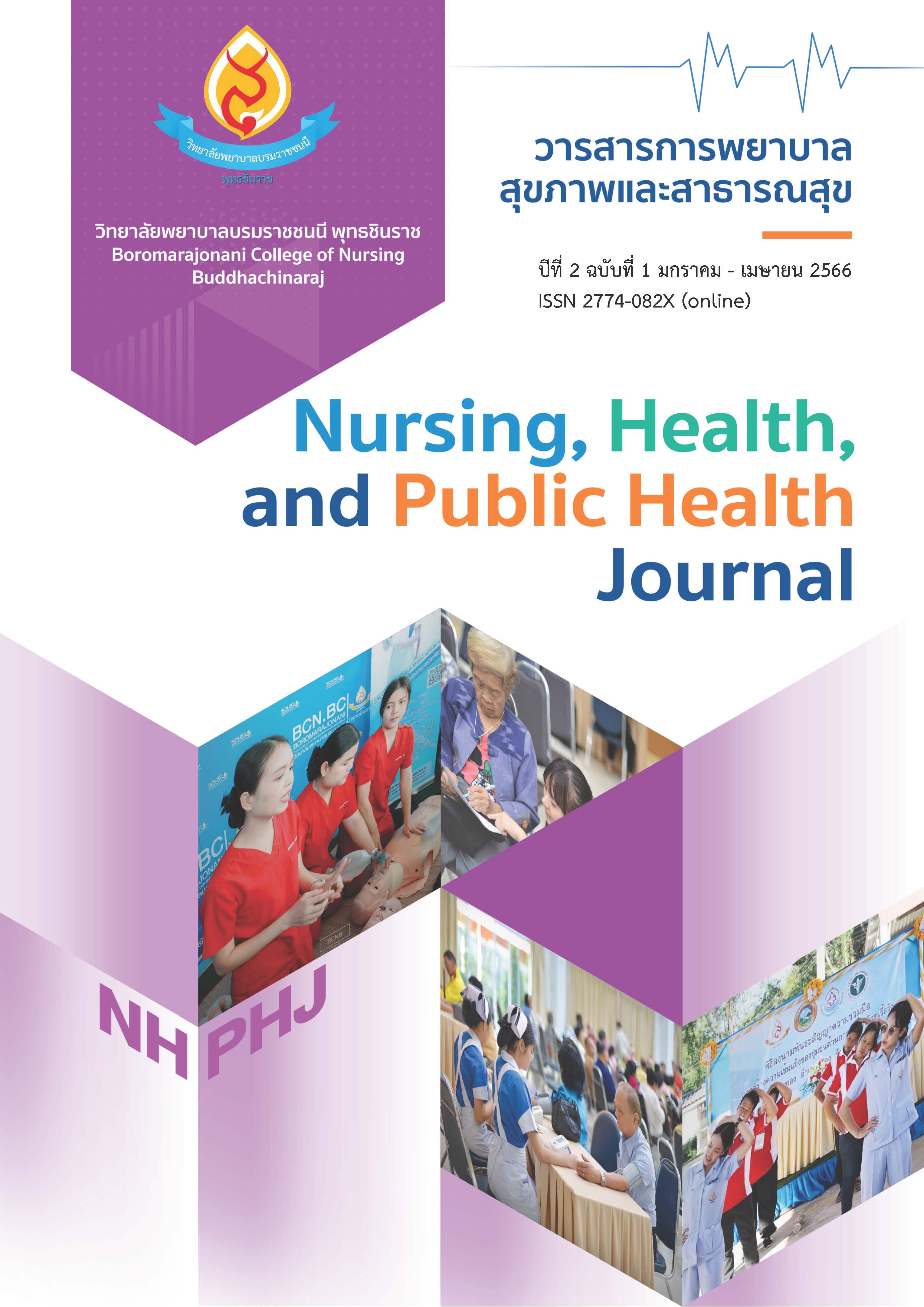Quality and identity of graduates who graduated in the academic year 2019 from the faculty of nursing, Naresuan University
Keywords:
quality of graduate, identity of graduate, nursingAbstract
The purpose of this descriptive research was to study the quality and identity of graduates who completed their studies in the academic year 2019 at the Faculty of Nursing, Naresuan University. The population consisted of 93 head nurses or staff members who work with these graduates. The data collection tools included: 1) a general information inquiry form, 2) a questionnaire assessing the quality of graduates based on the standard qualifications’ framework for higher education in nursing, which covers 6 aspects, and 3) a graduate identity questionnaire aligned with the desired identities of Naresuan University students, which emphasizes being good, talented, disciplined, and proud of the nation. The research tools underwent quality checks for content validity (making corrections to questions that had an Index of Item-Objective Congruence (IOC) below 0.50) and reliability (Cronbach's alpha coefficients for research instruments 2 and 3 were 0.92 and 0.90, respectively). Data were analyzed using descriptive statistics, including percentage, mean, and standard deviation.
The study findings revealed that the overall quality of the graduates across 6 aspects was rated at a high level (Mean = 3.95, S.D. = 0.55). The aspect with the highest score was interpersonal skills and responsibility (Mean = 4.33, S.D. = 0.51), followed by ethics and morals (Mean = 4.29, S.D. = 0.52), knowledge (Mean = 4.05, S.D. = 0.61), professional practice skills (Mean = 3.85, S.D. = 0.54), numerical analysis, communication, and information technology skills (Mean = 3.81, S.D. = 0.54), with cognitive skills scoring the lowest (Mean = 3.39, S.D. = 0.56).
Regarding the identity of the graduates, the overall score for all 4 aspects was also at a high level (Mean = 4.18, S.D. = 0.57). The highest score was for being a good person (Mean = 4.33, S.D. = 0.57), followed by discipline (Mean = 4.30, S.D. = 0.58), pride in the nation (Mean = 4.27, S.D. = 0.62), and the lowest score was for being a talented person (Mean = 3.81, S.D. = 0.50). Therefore, it is recommended that the faculty of nursing at Naresuan University focus on developing graduates with higher cognitive skills and a stronger talent-based identity.
References
กรกาญจน์ ปานสุวรรณ. (2564). รายงานการประเมินตนเองระดับหลักสูตร หลักสูตรพยาบาลศาสตรบัณฑิต (หลักสูตรปรับปรุง พ.ศ. 2559) คณะพยาบาลศาสตร์ มหาวิทยาลัยนเรศวร ประจำปีการศึกษา 2563. คณะพยาบาลศาสตร์ มหาวิทยาลัยนเรศวร.
กรกาญจน์ ปานสุวรรณ, กนกอร คล้ายจันทร์, ชนิกานต์ เสือสิงห์, และ นิตยา ศรีบัวรมย์. (2563). คุณภาพและอัตลักษณ์ของนิสิตตามการรับรู้ของผู้ใช้บัณฑิตที่สำเร็จการศึกษาจากคณะพยาบาลศาสตร์ มหาวิทยาลัยนเรศวร. วารสารการพยาบาลและสุขภาพ, 14(1), 54-65.
กรกาญจน์ ปานสุวรรณ, อินทิรา ปากันทะ, ภัทรมนัส พงศ์รังสรรค์, และ จรรยา มากโภคา. (2564). การประเมินหลักสูตรพยาบาลศาสตรบัณฑิต (หลักสูตรปรับปรุง พ.ศ. 2554) คณะพยาบาลศาสตร์ มหาวิทยาลัยนเรศวร. วารสารการพยาบาลและสุขภาพ, 15(2), 136-149.
คณะกรรมการประกันคุณภาพภายในระดับอุดมศึกษา และคณะอนุกรรมการพัฒนาการประกันคุณภาพการศึกษาภายในระดับอุดมศึกษา. (2560). คู่มือการประกันคุณภาพการศึกษาภายใน ระดับอุดมศึกษา พ.ศ. 2557. (พิมพ์ครั้งที่ 3). ภาพพิมพ์.
คณะพยาบาลศาสตร์ มหาวิทยาลัยนเรศวร. (2559). หลักสูตรพยาบาลศาสตรบัณฑิต (หลักสูตรปรับปรุง พ.ศ. 2559). คณะพยาบาลศาสตร์ มหาวิทยาลัยนเรศวร.
ฉัตรทิพย์ สุวรรณชิน และ พนมพร จันทรปัญญา. (2558). การสร้างอัตลักษณ์ของผู้เรียนในระดับอุดมศึกษา. วารสารปัญญาภิวัฒน์, 7(2), 267-280.
เติมศักดิ์ สุขวิบูลย์. (2552). ข้อคำนึงในการสร้างเครื่องมือประเภทมาตรประมาณค่า (Rating scale) เพื่องานวิจัย. https://www.ms.src.ku.ac.th › schedule › Files › Oct
ปัทมาภรณ์ คงขุนทด, ฉัตรทอง จารุพิสิฐไพบูลย์, นุชมาศ แก้วกุลฑล, นฤมล เปรมาสวัสดิ์, และ มยุรี พางาม. (2563). ความคิดเห็นของผู้ใช้บัณฑิตต่อคุณภาพบัณฑิตและอัตลักษณ์ของพยาบาลจบใหม่ที่สำเร็จการศึกษาจาก วิทยาลัยพยาบาลบรมราชชนนี นครราชสีมา ปีการศึกษา 2561. วารสารวิชาการสาธารณสุข, 29(6), 1086-1094.
ราชบัณฑิตยสถาน. (2555). พจนานุกรมศัพท์ศึกษาศาสตร์ ฉบับราชบัณฑิตยสถาน. อรุณการพิมพ์.
วิภาพร สิทธิสาตร์ และ สมาภรณ์ เทียนขาว. (2560). คุณภาพบัณฑิตและอัตลักษณ์บัณฑิต หลักสูตรพยาบาลศาสตรบัณฑิต วิทยาลัยพยาบาลบรมราชชนนี พุทธชินราช. วารสารพยาบาลศาสตร์ มหาวิทยาลัยสยาม, 18(34), 49-61.
สิรีวัฒน์ อายุวัฒน์, ชนกานต์ แสงคํากุล, และ กีรติ กิจธีระวุฒวงษ์. (2562). ผลของการเรียนการสอนโดยใช้ปัญหาเป็นหลักต่อทักษะการคิดอย่างมีวิจารณญาณของนักศึกษาพยาบาลหลักสูตรพยาบาลศาสตรบัณฑิต. วารสารพยาบาลสงขลานครินทร์, 39(2), 87-97.
สุภาพร แนวบุตร และ สมาพร ฉิมนาค. (2562). อัตลักษณ์ 5 เก่งของนิสิตพยาบาลศาสตร์ มหาวิทยาลัยนเรศวร. วารสารศึกษาศาสตร์ มหาวิทยาลัยศิลปากร, 17(2), 229-238.
สำนักมาตรฐานและประเมินผลอุดมศึกษา สำนักงานคณะกรรมการการอุดมศึกษา กระทรวงศึกษาธิการ. (2560). เกณฑ์มาตรฐานหลักสูตรระดับอุดมศึกษา พ.ศ. 2558 และเกณฑ์มาตรฐานที่เกี่ยวข้อง. บริษัท วงศ์สว่างพับลิชชิ่ง แอนด์ พริ้นติ้ง จำกัด.
AlMekkawi, M., & Khalil, R. E. (2020). New graduate nurses’ readiness to practice: A narrative literature review. Health Professions Education, 6(3), 304-316. https://doi.org/10.1016/j.hpe.2020.05.008
Dlamini, C. P., Mtshali, N. G., Dlamini, C. H., Mahanya, S., Shabangu, T., & Tsabedze, Z. (2014). New graduates’ readiness for practice in Swaziland: An exploration of stakeholders’ perspectives. Journal of Nursing Education and Practice, 4(5), 148-158. https://doi.org/10.5430/JNEP.V4N5P148
Larson, J., Brady, M., Engelmann, L., Perkins, B. I., & Shultz, C. (2013). The formation of professional identity in nursing. Nursing Education Perspectives, 34(2), 138.
Downloads
Published
How to Cite
Issue
Section
License
Copyright (c) 2023 Boromarajonani College of Nursing Buddhachinaraj

This work is licensed under a Creative Commons Attribution-NonCommercial-NoDerivatives 4.0 International License.


